Assessment for Learning: Roles, Methods, Benefits and Planning
VerifiedAdded on 2020/11/23
|5
|876
|148
Report
AI Summary
This report examines the multifaceted aspects of assessment for learning, focusing on the roles of teachers and learning support practitioners in evaluating student achievements. It contrasts formative and summative assessment methods, highlighting their distinct characteristics and applications in the learning process. The report emphasizes the importance and benefits of assessment for learning, including its role in providing feedback, setting goals, and improving student outcomes. Furthermore, it explores how assessment data can contribute to planning for future learning, involving teachers, students, and learning support practitioners in a collaborative effort to enhance educational strategies and student success. The report references key literature on assessment practices to support its findings.
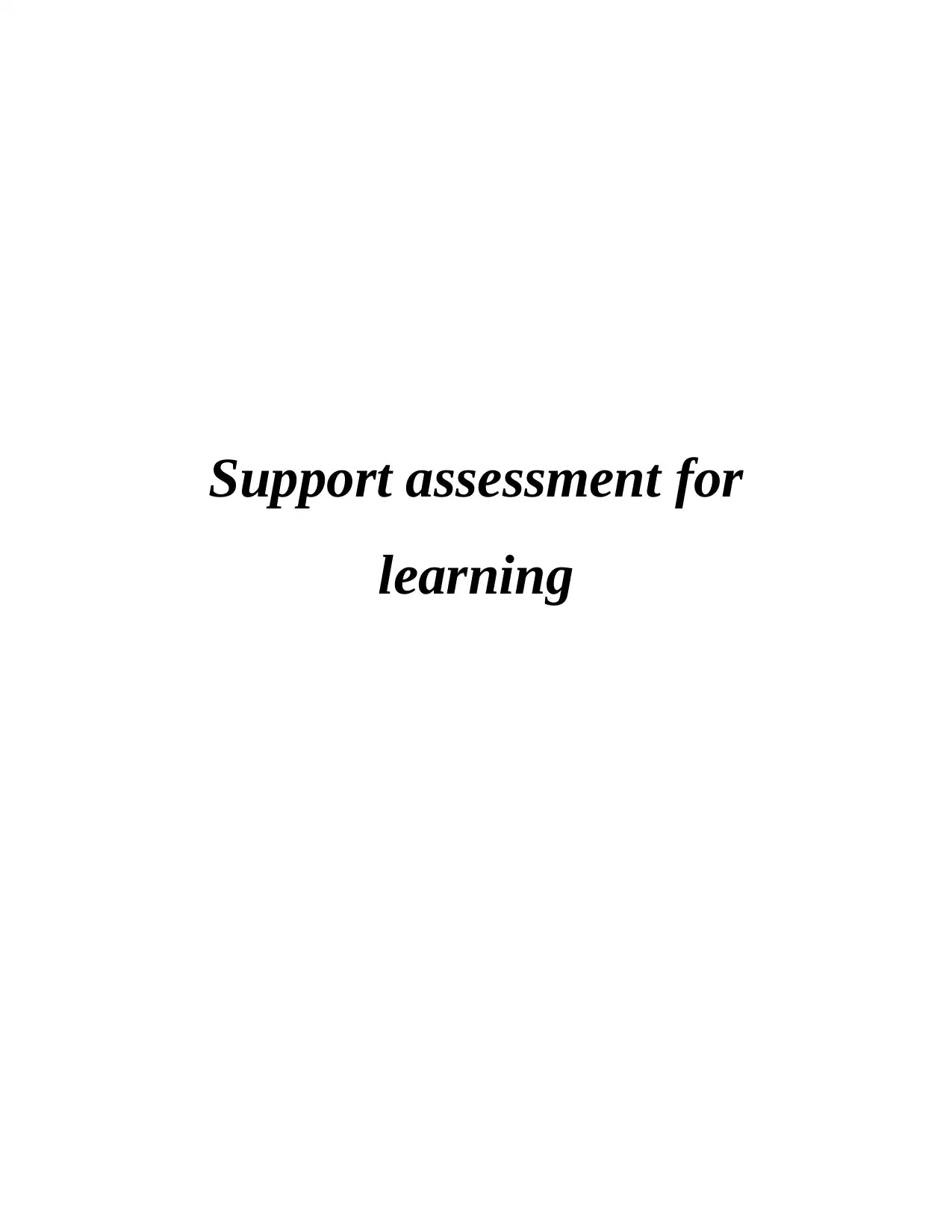
Support assessment for
learning
learning
Paraphrase This Document
Need a fresh take? Get an instant paraphrase of this document with our AI Paraphraser
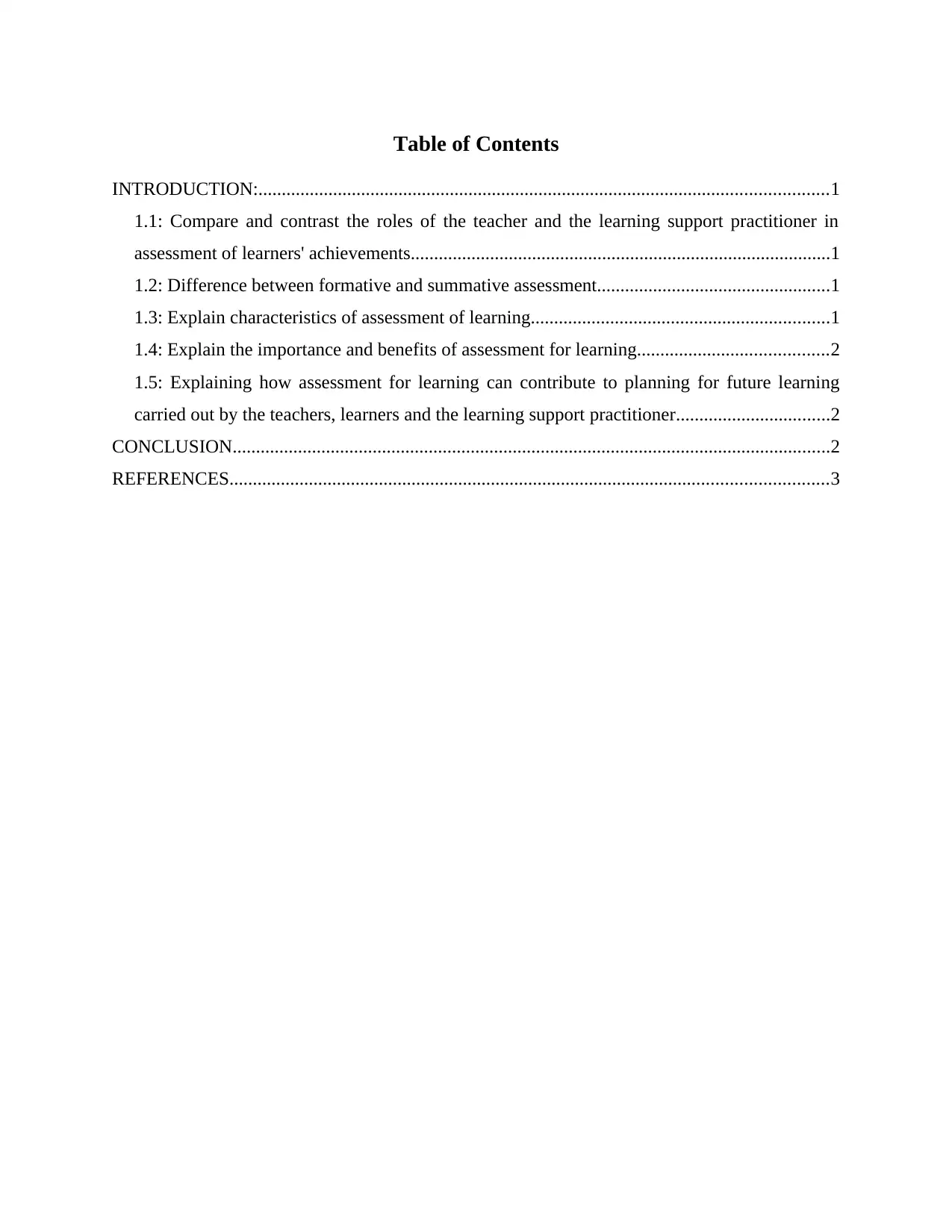
Table of Contents
INTRODUCTION:..........................................................................................................................1
1.1: Compare and contrast the roles of the teacher and the learning support practitioner in
assessment of learners' achievements..........................................................................................1
1.2: Difference between formative and summative assessment..................................................1
1.3: Explain characteristics of assessment of learning................................................................1
1.4: Explain the importance and benefits of assessment for learning.........................................2
1.5: Explaining how assessment for learning can contribute to planning for future learning
carried out by the teachers, learners and the learning support practitioner.................................2
CONCLUSION................................................................................................................................2
REFERENCES................................................................................................................................3
INTRODUCTION:..........................................................................................................................1
1.1: Compare and contrast the roles of the teacher and the learning support practitioner in
assessment of learners' achievements..........................................................................................1
1.2: Difference between formative and summative assessment..................................................1
1.3: Explain characteristics of assessment of learning................................................................1
1.4: Explain the importance and benefits of assessment for learning.........................................2
1.5: Explaining how assessment for learning can contribute to planning for future learning
carried out by the teachers, learners and the learning support practitioner.................................2
CONCLUSION................................................................................................................................2
REFERENCES................................................................................................................................3
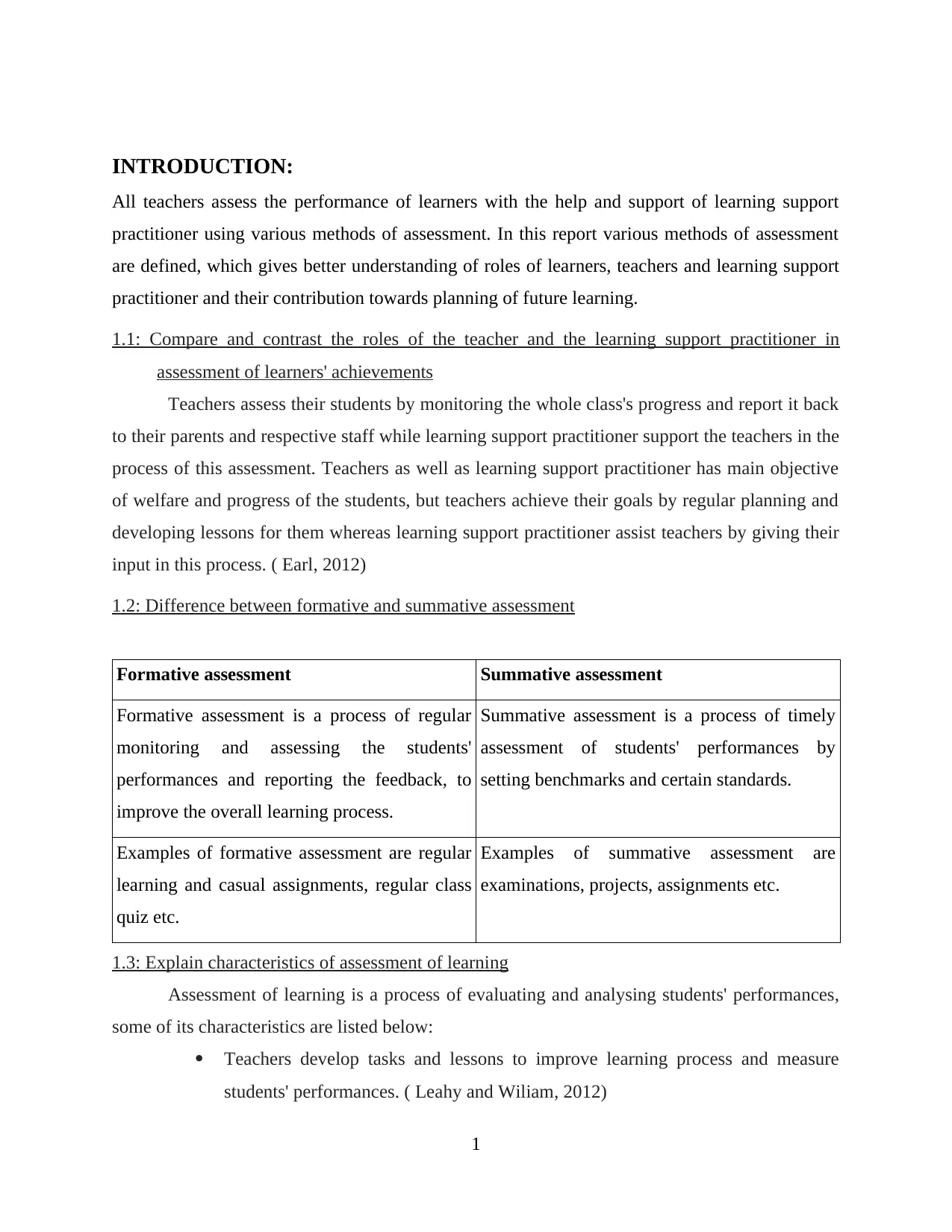
INTRODUCTION:
All teachers assess the performance of learners with the help and support of learning support
practitioner using various methods of assessment. In this report various methods of assessment
are defined, which gives better understanding of roles of learners, teachers and learning support
practitioner and their contribution towards planning of future learning.
1.1: Compare and contrast the roles of the teacher and the learning support practitioner in
assessment of learners' achievements
Teachers assess their students by monitoring the whole class's progress and report it back
to their parents and respective staff while learning support practitioner support the teachers in the
process of this assessment. Teachers as well as learning support practitioner has main objective
of welfare and progress of the students, but teachers achieve their goals by regular planning and
developing lessons for them whereas learning support practitioner assist teachers by giving their
input in this process. ( Earl, 2012)
1.2: Difference between formative and summative assessment
Formative assessment Summative assessment
Formative assessment is a process of regular
monitoring and assessing the students'
performances and reporting the feedback, to
improve the overall learning process.
Summative assessment is a process of timely
assessment of students' performances by
setting benchmarks and certain standards.
Examples of formative assessment are regular
learning and casual assignments, regular class
quiz etc.
Examples of summative assessment are
examinations, projects, assignments etc.
1.3: Explain characteristics of assessment of learning
Assessment of learning is a process of evaluating and analysing students' performances,
some of its characteristics are listed below:
Teachers develop tasks and lessons to improve learning process and measure
students' performances. ( Leahy and Wiliam, 2012)
1
All teachers assess the performance of learners with the help and support of learning support
practitioner using various methods of assessment. In this report various methods of assessment
are defined, which gives better understanding of roles of learners, teachers and learning support
practitioner and their contribution towards planning of future learning.
1.1: Compare and contrast the roles of the teacher and the learning support practitioner in
assessment of learners' achievements
Teachers assess their students by monitoring the whole class's progress and report it back
to their parents and respective staff while learning support practitioner support the teachers in the
process of this assessment. Teachers as well as learning support practitioner has main objective
of welfare and progress of the students, but teachers achieve their goals by regular planning and
developing lessons for them whereas learning support practitioner assist teachers by giving their
input in this process. ( Earl, 2012)
1.2: Difference between formative and summative assessment
Formative assessment Summative assessment
Formative assessment is a process of regular
monitoring and assessing the students'
performances and reporting the feedback, to
improve the overall learning process.
Summative assessment is a process of timely
assessment of students' performances by
setting benchmarks and certain standards.
Examples of formative assessment are regular
learning and casual assignments, regular class
quiz etc.
Examples of summative assessment are
examinations, projects, assignments etc.
1.3: Explain characteristics of assessment of learning
Assessment of learning is a process of evaluating and analysing students' performances,
some of its characteristics are listed below:
Teachers develop tasks and lessons to improve learning process and measure
students' performances. ( Leahy and Wiliam, 2012)
1
⊘ This is a preview!⊘
Do you want full access?
Subscribe today to unlock all pages.

Trusted by 1+ million students worldwide
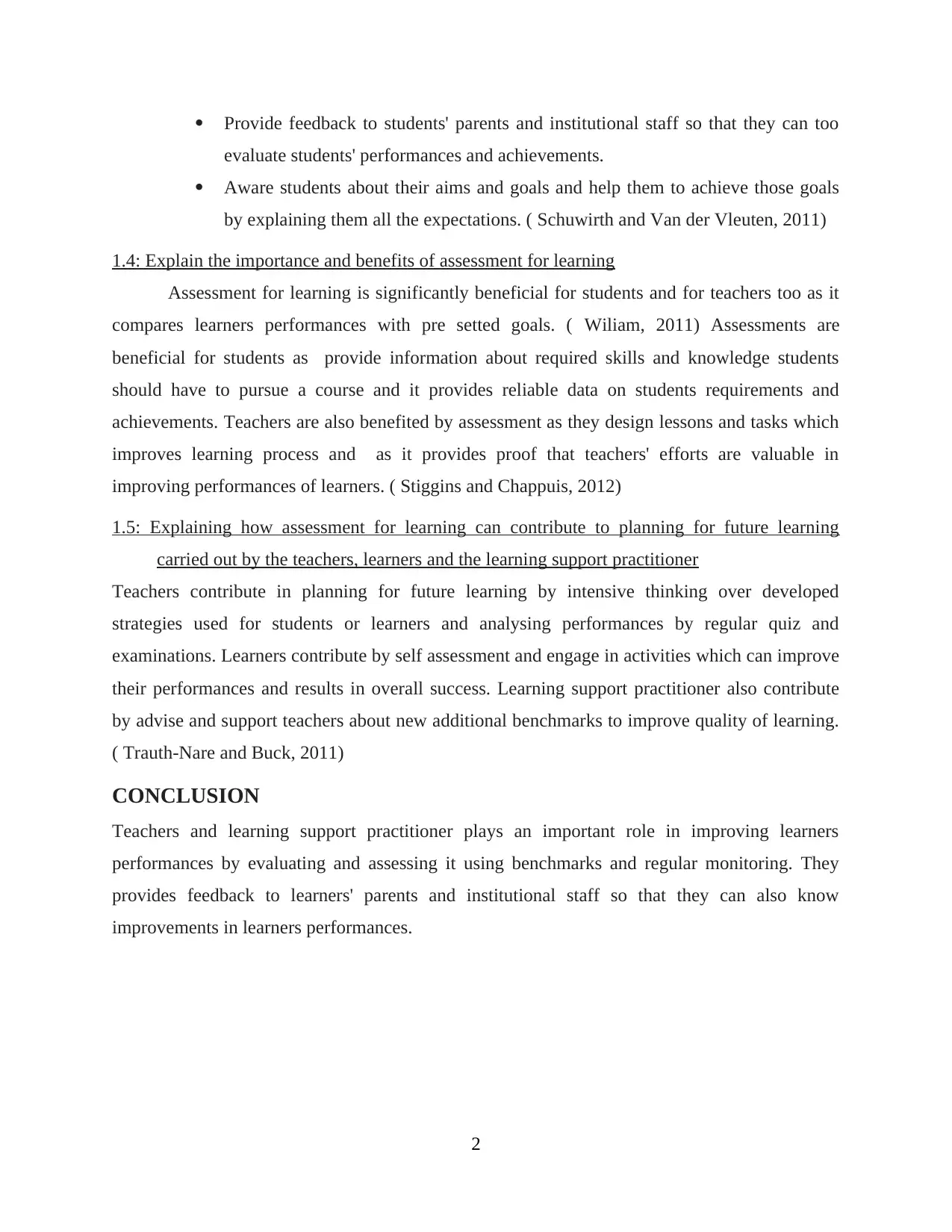
Provide feedback to students' parents and institutional staff so that they can too
evaluate students' performances and achievements.
Aware students about their aims and goals and help them to achieve those goals
by explaining them all the expectations. ( Schuwirth and Van der Vleuten, 2011)
1.4: Explain the importance and benefits of assessment for learning
Assessment for learning is significantly beneficial for students and for teachers too as it
compares learners performances with pre setted goals. ( Wiliam, 2011) Assessments are
beneficial for students as provide information about required skills and knowledge students
should have to pursue a course and it provides reliable data on students requirements and
achievements. Teachers are also benefited by assessment as they design lessons and tasks which
improves learning process and as it provides proof that teachers' efforts are valuable in
improving performances of learners. ( Stiggins and Chappuis, 2012)
1.5: Explaining how assessment for learning can contribute to planning for future learning
carried out by the teachers, learners and the learning support practitioner
Teachers contribute in planning for future learning by intensive thinking over developed
strategies used for students or learners and analysing performances by regular quiz and
examinations. Learners contribute by self assessment and engage in activities which can improve
their performances and results in overall success. Learning support practitioner also contribute
by advise and support teachers about new additional benchmarks to improve quality of learning.
( Trauth-Nare and Buck, 2011)
CONCLUSION
Teachers and learning support practitioner plays an important role in improving learners
performances by evaluating and assessing it using benchmarks and regular monitoring. They
provides feedback to learners' parents and institutional staff so that they can also know
improvements in learners performances.
2
evaluate students' performances and achievements.
Aware students about their aims and goals and help them to achieve those goals
by explaining them all the expectations. ( Schuwirth and Van der Vleuten, 2011)
1.4: Explain the importance and benefits of assessment for learning
Assessment for learning is significantly beneficial for students and for teachers too as it
compares learners performances with pre setted goals. ( Wiliam, 2011) Assessments are
beneficial for students as provide information about required skills and knowledge students
should have to pursue a course and it provides reliable data on students requirements and
achievements. Teachers are also benefited by assessment as they design lessons and tasks which
improves learning process and as it provides proof that teachers' efforts are valuable in
improving performances of learners. ( Stiggins and Chappuis, 2012)
1.5: Explaining how assessment for learning can contribute to planning for future learning
carried out by the teachers, learners and the learning support practitioner
Teachers contribute in planning for future learning by intensive thinking over developed
strategies used for students or learners and analysing performances by regular quiz and
examinations. Learners contribute by self assessment and engage in activities which can improve
their performances and results in overall success. Learning support practitioner also contribute
by advise and support teachers about new additional benchmarks to improve quality of learning.
( Trauth-Nare and Buck, 2011)
CONCLUSION
Teachers and learning support practitioner plays an important role in improving learners
performances by evaluating and assessing it using benchmarks and regular monitoring. They
provides feedback to learners' parents and institutional staff so that they can also know
improvements in learners performances.
2
Paraphrase This Document
Need a fresh take? Get an instant paraphrase of this document with our AI Paraphraser
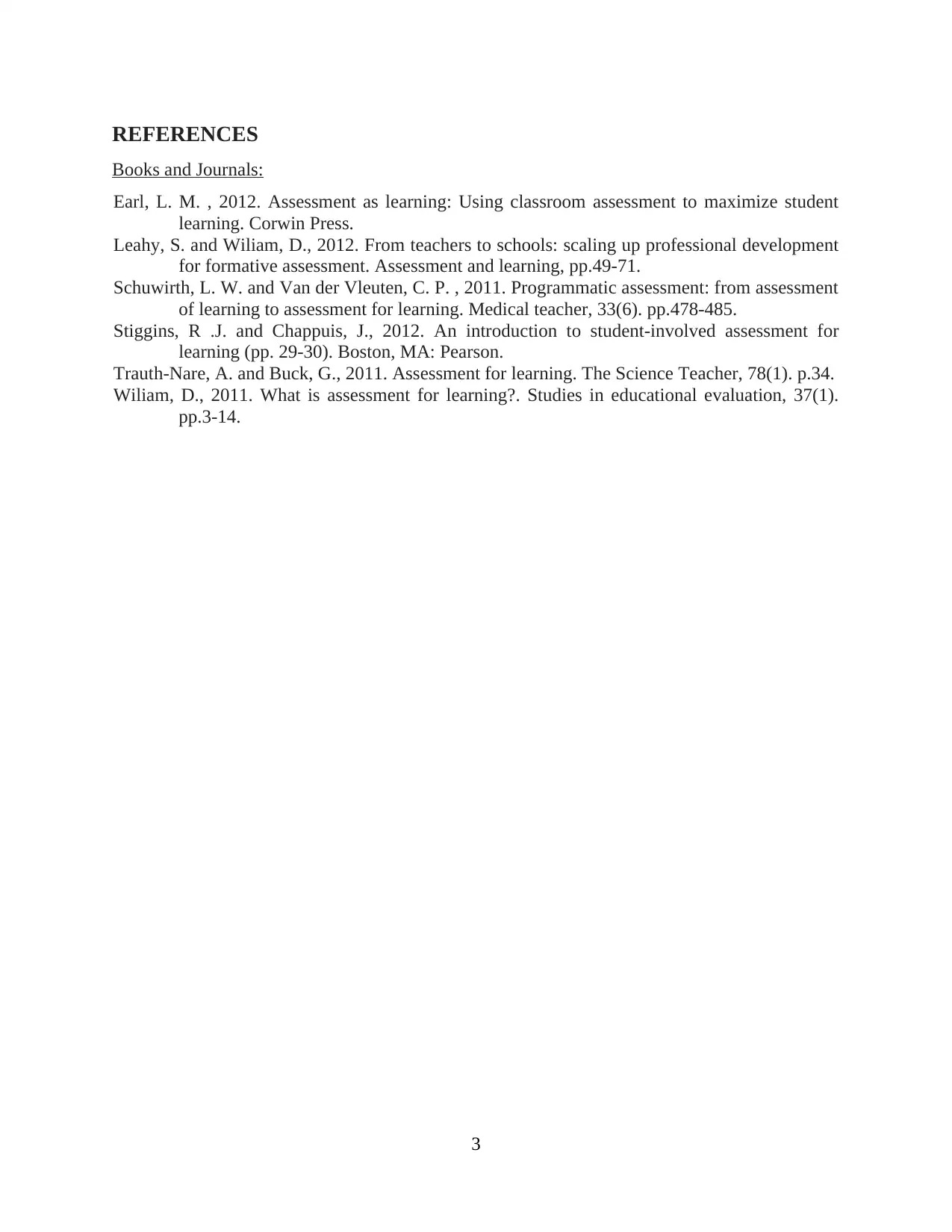
REFERENCES
Books and Journals:
Earl, L. M. , 2012. Assessment as learning: Using classroom assessment to maximize student
learning. Corwin Press.
Leahy, S. and Wiliam, D., 2012. From teachers to schools: scaling up professional development
for formative assessment. Assessment and learning, pp.49-71.
Schuwirth, L. W. and Van der Vleuten, C. P. , 2011. Programmatic assessment: from assessment
of learning to assessment for learning. Medical teacher, 33(6). pp.478-485.
Stiggins, R .J. and Chappuis, J., 2012. An introduction to student-involved assessment for
learning (pp. 29-30). Boston, MA: Pearson.
Trauth-Nare, A. and Buck, G., 2011. Assessment for learning. The Science Teacher, 78(1). p.34.
Wiliam, D., 2011. What is assessment for learning?. Studies in educational evaluation, 37(1).
pp.3-14.
3
Books and Journals:
Earl, L. M. , 2012. Assessment as learning: Using classroom assessment to maximize student
learning. Corwin Press.
Leahy, S. and Wiliam, D., 2012. From teachers to schools: scaling up professional development
for formative assessment. Assessment and learning, pp.49-71.
Schuwirth, L. W. and Van der Vleuten, C. P. , 2011. Programmatic assessment: from assessment
of learning to assessment for learning. Medical teacher, 33(6). pp.478-485.
Stiggins, R .J. and Chappuis, J., 2012. An introduction to student-involved assessment for
learning (pp. 29-30). Boston, MA: Pearson.
Trauth-Nare, A. and Buck, G., 2011. Assessment for learning. The Science Teacher, 78(1). p.34.
Wiliam, D., 2011. What is assessment for learning?. Studies in educational evaluation, 37(1).
pp.3-14.
3
1 out of 5
Related Documents
Your All-in-One AI-Powered Toolkit for Academic Success.
+13062052269
info@desklib.com
Available 24*7 on WhatsApp / Email
![[object Object]](/_next/static/media/star-bottom.7253800d.svg)
Unlock your academic potential
Copyright © 2020–2025 A2Z Services. All Rights Reserved. Developed and managed by ZUCOL.





